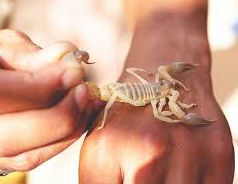JOURNALS || Health & Medicine Blog (ASIO)
BACKGROUND
Scorpion stings are a major public health problem in many underdeveloped tropical and subtropical countries, especially Sahelian Africa, South India, the Middle East, Mexico, and South Latin America. The estimated annual number of scorpion stings is 1.2 million leading to 3250 deaths (0.27%). For every person killed by a venomous snake, 10 are killed by a venomous scorpion. In Mexico, 1000 deaths from scorpion stings occur per year. In the United States, only 4 deaths in 11 years have occurred as a result of scorpion stings. Furthermore, scorpions can be found outside their normal range of distribution, that is when they crawl into luggage, boxes, containers, or shoes and are unwittingly transported home via human travelers.

INTRODUCTION
Scorpions have a segmented tail. The tip of the tail holds a stinger and two glands that contain a poisonous substance (venom) that helps scorpions protect themselves. When surprised or threatened, a scorpion may poke the stinger into an animal or person and inject them with venom. People sometimes call this event a scorpion bite, but it is a sting, not a bite.
SYMPTOMS
Most scorpion stings cause only local pain and swelling and respond to local measures such as cold compresses and wound care.
Symptoms can be extremely intense, even if swelling or redness isn’t visible. Regional lymph nodes may enlarge, and there may be an allergic reaction characterized by swelling of the eyelids, tongue, and vomiting.
Systemic symptoms can occur within 30 minutes of envenomation (It is exposure to a poison or toxin resulting from a bite or sting from an animal such as a snake, scorpion, spider or insect, or from marine life) and include nausea, vomiting, sweating, blurred vision, excessive salivation, itching of the nose and throat, anxiety, restlessness, hyperthermia, muscle spasms, hypertension, hemiplegia, syncope, pseudoseizures, cardiac arrhythmia, and respiratory failure.
Symptoms related to widespread effects of venom can include:
- breathing difficulties
- muscle thrashing or twitching
- unusual movements of the neck, head, and eyes
- dribbling or drooling
- sweating
- accelerated heart rate or irregular heartbeat
- restlessness, excitability, or inconsolable crying
It’s also possible for people who’ve been stung previously by scorpions to have an allergic reaction to a subsequent sting. It’s occasionally severe enough to cause a life-threatening condition called anaphylaxis. Symptoms in these cases are similar to those of anaphylaxis caused by bee stings and can include trouble breathing, hives, nausea, and vomiting.
COMPLICATIONS AND ASSOCIATED CONDITIONS
A number of species, however, possess potent venom and can cause significant envenomations. These species include the bark scorpion (Centruroides spp.) found in the Southwestern United States, scorpions of the genus Tityus in the Caribbean, and members of the genera Androctonus, Buthus, and Parabuthus in Africa. Such scorpion stings can result in excess cholinergic activity with symptoms of delirium, nausea, bradycardia, salivation, and sweating. With some species, adrenergic toxicity and tissue necrosis can also occur. Treatment is supportive.
TREATMENT
Put ice on the area to bring down the swelling. Take an antihistamine or use a hydrocortisone cream to ease inflammation and itching.
Treatment methods are controversial. Symptomatic treatment of autonomic storm with vasodilators or a combination of nifedipine and prazosin has been shown to be effective. Antisera are available as indicated in. However, it remains to be established which envenomations and which patients are more likely to benefit from antivenom therapy
Pain responds temporarily to local infiltration or ring block with local anesthetic. Although they are said to relieve pain, local injection of emetine or dehydroemetine may cause necrosis and systemic myotoxic effects and are not recommended. Parenteral opiate analgesics, such as meperidine (pethidine) or morphine, may be required.
1. https://emedicine.medscape.com/article/168230-overview
2. https://my.clevelandclinic.org/health/diseases/17860-scorpion-stings
3. https://www.webmd.com/allergies/scorpion-stings
4. https://www.healthline.com/health/scorpion-sting#complications
5. https://www.sciencedirect.com/science/article/pii/B9781416068372000087
6. https://www.sciencedirect.com/science/article/pii/B9781416043904001363
7. https://www.sciencedirect.com/science/article/pii/B9780444815576500356



